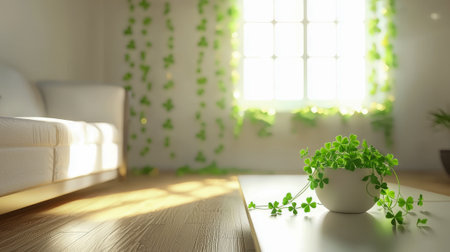Introduction to Indoor Greenery Trends in India
In recent years, urban homes across India have embraced a fresh wave of interior styling: the use of indoor plants to create vibrant green corners. As city living spaces become more compact and bustling, the desire for a touch of nature within our four walls has grown significantly. Indian homeowners and renters alike are now turning to lush foliage and potted greens to infuse their homes with serenity, beauty, and improved air quality. This trend goes beyond simple decoration—it is about crafting calming retreats in busy urban environments, reflecting both modern sensibilities and traditional Indian reverence for nature. The rise of indoor greenery is redefining home aesthetics in cities like Mumbai, Bangalore, and Delhi, making plant-filled corners a must-have feature for today’s city dwellers.
2. Choosing the Right Indoor Plants for Indian Homes
When it comes to bringing more greenery into your home corners, selecting the right indoor plants is essential, especially given India’s diverse climates and unique cultural preferences. Not only should these plants thrive indoors, but they should also align with traditional beliefs such as vastu shastra for positive energy and well-being.
Popular and Vastu-Friendly Indoor Plants
| Plant Name | Vastu Benefits | Care Tips | Best Placement |
|---|---|---|---|
| Tulsi (Holy Basil) | Purifies air, brings positivity, considered sacred in Indian homes | Needs sunlight, water regularly, avoid waterlogging | Near windows or balconies facing east or north-east |
| Money Plant (Epipremnum aureum) | Attracts prosperity and good luck according to vastu | Thrives in low light, water moderately, can be grown in soil or water | Living room corners or on shelves; avoid placing near head of bed |
| Areca Palm (Dypsis lutescens) | Cleanses indoor air and adds calming energy to spaces | Loves indirect light, keep soil moist but not soggy | Living rooms, office corners, or entrance areas |
| Aloe Vera | Heals and protects against negative vibes; medicinal uses too | Requires bright light, minimal watering once soil dries out | Kitchen windowsill or balcony garden |
| Snake Plant (Sansevieria) | Removes toxins from air and offers protection per vastu | Tolerates low light, water sparingly—ideal for busy lifestyles | Bedroom corner or study area for fresh air at night |
Selecting Plants for Indian Climates & Lifestyles
The Indian climate ranges from humid coastal regions to dry interiors. For coastal cities like Mumbai or Chennai, opt for moisture-loving plants such as Areca Palm. In drier regions like Delhi or Jaipur, drought-tolerant options like Snake Plant and Aloe Vera are excellent choices. Also consider your lifestyle: if you have limited time for plant care, choose hardy varieties that need less attention.
Tips for Successful Plant Selection:
- Space Considerations: Pick compact plants like Money Plant for small apartments; larger homes can feature statement palms.
- Pots & Planters: Use ceramic pots with drainage holes to prevent root rot, a common issue in humid Indian conditions.
- Cultural Significance: Incorporate Tulsi or other sacred plants into your puja corner to harmonise tradition with new trends.
- Light Availability: Assess natural light before choosing—most indoor plants prefer indirect sunlight common in urban Indian homes.
- Pest Management: Occasionally wipe leaves and check for pests since warm temperatures can attract bugs indoors.
Create a Green Sanctuary That Resonates With You!
Selecting the right indoor plants not only enhances home aesthetics but also supports health, positivity, and traditional values in everyday Indian living. Choose wisely to transform your home corners into lush green retreats that reflect both modern trends and timeless culture.

3. Creative Corner Décor Ideas
Transforming neglected corners into lush green nooks is the latest home décor trend in India, where space is often at a premium. Smart use of vertical spaces, especially in apartments, can instantly add freshness and style. One innovative way to decorate is by using hanging planters. Suspended from the ceiling or mounted on wall brackets, they not only save floor space but also create a cascading effect of greenery that uplifts any room.
Upcycled Pots: Sustainable and Stylish
In line with Indian values of jugaad and sustainability, upcycling old containers—like steel dabbas, clay matkas, or even colourful chai kettles—into plant pots is both eco-friendly and eye-catching. These upcycled planters bring a nostalgic touch while promoting conscious living. You can paint them in vibrant hues or wrap them with jute for an earthy vibe that complements traditional Indian interiors.
Traditional Touches with Jharokhas and More
Integrating traditional elements such as jharokhas—the ornate window frames commonly seen in Rajasthani architecture—adds cultural depth to your indoor garden corners. Place small potted plants inside jharokha frames or mount them above a cluster of indoor greens for a regal look. Accentuate these spaces further with terracotta diyas, brass figurines, or hand-painted wall plates to weave together modern trends and heritage charm.
Smart Arrangements for Urban Spaces
If you’re working with compact corners, opt for tiered plant stands or ladder shelves to display multiple plants vertically. Mix leafy greens like money plants with flowering varieties such as peace lilies for colour and texture contrast. For balconies and sunlit nooks, trailing vines like pothos or string of pearls work beautifully in macramé hangers, enhancing the urban jungle feel while staying rooted in Indian aesthetics.
4. Space-Saving Techniques for Urban Homes
With the rising trend of indoor greenery in Indian metros like Mumbai, Delhi, and Bengaluru, utilising every inch of your apartment smartly is a must. Even in compact flats or studio apartments, you can create lush green corners with some desi jugaad and creativity.
Vertical Gardens: The Ultimate Urban Hack
Wall-mounted planters and DIY vertical gardens are perfect for cramped spaces. Use metal racks, recycled bottles, or even old ladders to arrange your favourite pothos, money plants, or snake plants vertically. Not only does this maximise space, but it also adds a modern touch to your interiors—something that’s catching on fast among urban millennials.
Window Sills: Miniature Green Retreats
Your window sills are prime real estate for small pots of tulsi, succulents, or spider plants. These sunlit spots are ideal for herbs and low-maintenance indoor plants. Plus, nurturing a tulsi plant by the window is an age-old Indian tradition that brings positive vibes to the home.
Balcony Transformations: From Utility to Oasis
Don’t let your balcony be just a laundry corner! Convert it into a green oasis with hanging baskets, railing planters, or tiered plant stands. Even in smaller balconies typical of Indian cities, you can grow everything from flowering plants to chillies and curry leaves.
Comparison Table: Space-Saving Plant Ideas for Metro Apartments
| Technique | Best For | Popular Indian Plants | Pro Tip |
|---|---|---|---|
| Vertical Gardens | Narrow walls & corridors | Money Plant, Areca Palm | Use recycled materials for eco-friendly decor |
| Window Sills | Kitchen & living room windows | Tulsi, Succulents | Select sun-loving plants for east-facing windows |
| Balcony Makeover | Small balconies & patios | Curry Leaf, Hibiscus | Add fairy lights for a cosy vibe during evenings |
Quick Tips for Maximum Greenery in Minimum Space:
- Opt for multi-level stands to stack more pots vertically.
- Choose lightweight planters that are easy to move around as per sunlight availability.
- Mix fragrant herbs like pudina (mint) and lemongrass with ornamental greens for both beauty and utility.
- If you’re short on time, low-maintenance options like ZZ plant or peace lily will thrive with minimal care.
By applying these smart hacks rooted in Indian sensibilities, even a tiny city home can bloom into a green haven without sacrificing precious floor space. Urban jungles are now not just a trend—they’re the new way of life!
5. Benefits of Embracing Indoor Plants
Cultural Significance: Connecting with Indian Traditions
Indoor plants have always had a deep-rooted significance in Indian homes. From the sacred Tulsi plant placed near entrances to the auspicious money plant believed to attract prosperity, greenery is interwoven with our cultural fabric. These plants are not just decorative—they represent life, growth, and positivity. Many Indian households believe that nurturing indoor plants brings good fortune and wards off negative energy, following principles from Vastu Shastra and ancient customs.
Health Advantages: Purifying Air and Enhancing Well-being
With increasing urbanisation in India’s cities, air quality is often a concern. Indoor plants like Areca Palm, Snake Plant, and Aloe Vera act as natural air purifiers by absorbing toxins and releasing oxygen. This can be especially beneficial in metro apartments where ventilation may be limited. Studies show that having greenery indoors reduces stress levels, boosts mood, and even helps improve concentration—a boon for families balancing work-from-home lifestyles.
Aesthetic Appeal: Transforming Home Corners into Green Oases
Decorating home corners with lush foliage adds a refreshing touch to any space. Whether it’s a balcony filled with spider plants or a living room corner adorned with succulents and ferns, indoor greenery instantly livens up interiors. The contrast between vibrant greens and traditional Indian décor—think terracotta pots or brass planters—creates an inviting ambience that reflects personal style while staying rooted in local aesthetics.
Holistic Benefits: Fostering Harmony and Positive Energy
Beyond their visual charm and health perks, indoor plants are cherished for the sense of tranquility they bring. In Indian culture, green spaces are associated with harmony and spiritual well-being. Nurturing a small indoor garden can be a meditative ritual—watering, pruning, and caring for your plants offers moments of mindfulness amidst daily hustle. Ultimately, embracing this trend means blending tradition with modern living, creating homes that breathe life and positivity at every corner.
6. Sustainable Plant Care Tips
Embracing indoor plants in your home corners is not only about enhancing aesthetics, but also about nurturing them responsibly. For urban Indian homes where time and resources can be limited, adopting sustainable plant care practices makes a real difference. Here are some eco-friendly tips tailored for busy city lifestyles:
Opt for Water-Saving Techniques
In many Indian cities, water conservation is essential. Choose drought-tolerant plants like succulents or snake plants that thrive with minimal watering. Use drip trays to collect excess water and reuse it for other plants. Consider watering early in the morning or late evening to reduce evaporation, making every drop count.
Use Natural Fertilisers
Instead of chemical fertilisers, enrich your plant soil with homemade compost from kitchen scraps like fruit peels and tea leaves. This not only reduces household waste but also provides essential nutrients for your indoor greens.
Choose Upcycled Pots and Containers
Give new life to old clay matkas, brass vessels, or even painted tin cans as unique plant pots. This approach aligns with Indian traditions of jugaad (resourcefulness) while reducing plastic use and promoting sustainability.
Follow Easy Maintenance Routines
Create a simple weekly schedule: dust leaves gently with a damp cloth, rotate pots for even sunlight, and check soil moisture with your finger before watering. For busy professionals, self-watering planters or arranging plants in groups makes daily care more manageable.
Reduce Chemical Usage
Control pests naturally by spraying diluted neem oil or using turmeric powder around plant bases—a practice rooted in Indian households. These organic remedies keep your plants healthy without harming the environment.
Support Local Nurseries
Whenever possible, purchase indoor plants from local nurseries or community markets. This not only supports small businesses but also ensures you get varieties well-suited to Indian climates and urban homes.
Sustainable care turns your green corners into thriving, eco-friendly sanctuaries—adding both beauty and positive energy to your living space, the Indian way.

